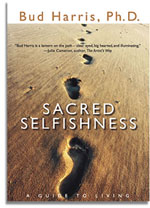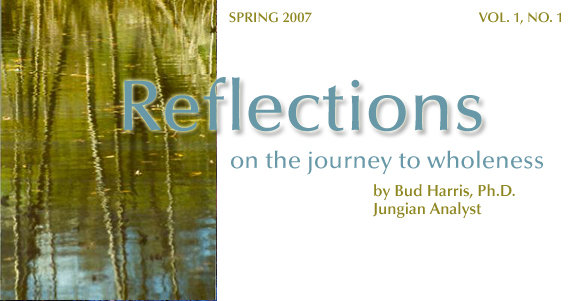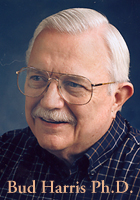In the early 1970’s I joined a Centerpoint group and began learning about Jungian psychology. Within a couple of years a number of us who were pursuing this path founded the Jung Society of Atlanta. Then I jumped into a larger sea and went to Zurich to train to become an analyst.
These many years later, I am starting this quarterly newsletter because I want to share my thoughts with people in groups similar to the ones that are important to my journey. I want this newsletter to be a sharing, to some extent a giving back, but also a help in connecting us to a larger community. In addition I am looking forward to the things we can learn from each other when you respond on the blog I’ve set up.
I hope that you will accept this invitation and that it will enrich all of our lives.
|
About a year ago I began my current journey by falling out of bed. In a sound sleep around two a.m., I rolled over and awakened falling. In a complete panic, I slammed my head on the night table and crashed to the floor. Blood spewed from the small vein I had cut on the corner of my eye and it began to swell. My wife, scared almost to death, ran for the ice. The ice soon stopped the bleeding and fortunately limited my swelling, although I still had a black eye that subjected me to days of wise-cracks by friends and analysands. Before the ice bag had even stopped the flow of blood, I winced inwardly. As someone who believes in wake-up calls, I knew I would have to think seriously about my life. Where had I missed a turn and become self-satisfied? How had I let the kind of defensiveness creep in that is more interested in having an easy going life than in growth and transformation? I have enough experience with life- enhancing events to realize that somewhere in the depths of my soul a secret hunger wanted to emerge; an obscure longing was demanding recognition and a place in my life. I had resisted change because I had a good life, a meaningful life and a busy, comfortable one. Plus, I’d also had my share of failures and courageous transformations. It seemed like at age 68 I should be able to coast a bit. The knock on the head was a wake-up call to realize that the Self, the Divine spark in the center of my soul, was still ambitious. It is charged with a strong desire to have my life fulfill a larger pattern and express potentials I have been slow to recognize. My wife, also an analyst, told me I should be glad it wasn’t worse, perhaps a heart attack. I’m not quite that hard to arouse anymore, though I once was.
As I was reflecting on this event I realized that I, an analyst who has been on the inner journey for over thirty years, had gradually let my busy practice become a defense against my own inner work. Not that I didn’t listen to my dreams and pay a certain amount of attention to what was going on in my unconscious. But I had slipped into a certain kind of complacency. I felt I was doing the work I was meant to do and had forgotten the credo, the definition of the path or myth I had pledged my heart to years ago. My first step was to return to what I call my spiritual practices: journaling, listening to dreams, and active imagination. I know very well that when I do these practices religiously my life transforms. Transformation begins because I have launched an odyssey of reconciliation and discovery—one that brings light and dark, the admired and denied, the redeemed and the unredeemed into clearer focus. New growth means opening the door once again to fear and failure because this is the same door that admits creativity and passion Journaling, the way I do it, isn’t just a diary or a place for expressing the thoughts and feelings I don’t want to say out loud. It is a dialog with my life that helps me understand myself better, create and recreate myself into a bigger version of who I am. I wrote a book about all of this called Sacred Selfishness. There’s nothing like considering yourself a successful analyst and having your Self knock you out of bed in the middle of the night, and in your reflections tell you to read your own book and rediscover your myth. My credo began to form when I first “bumped” into Jungian psychology in the early 1970’s. Pieces of my life began to fall into place: the search for wholeness; the teleological aspects of symptoms (how they are trying to heal us by pointing us toward living a bigger life); the uniqueness of each life; and the potentials born in struggle and suffering. Along with these is the effort, through self-knowledge, to know and experience the Divine by going beyond the conventions of religion and experiencing the Self supporting and directing my life. There is also the need for eros and the interplay between the creative and the receptive. Without this dynamic balance we are in danger of becoming either driven or stuck in passivity, both of which are places I know very well. Self-knowledge helps me see through my own complexes and illusions in order to more clearly see reality. Seeing reality brings individuality, and individuality is fully expressed when it is dissolved in the love of something bigger. My myth includes the acceptance of conflict and suffering. The search for love and meaning opens me to the glory of a life bigger and more surprising than I could have dreamed of or planned In Mysterium Coniunctionis (par 778) Jung reminds us that, “The Self in its efforts at self-realization, reaches out beyond the ego-personality on all sides; because of its all encompassing nature it is brighter and darker than the ego, and accordingly confronts it with problems which it would like to avoid.” He goes on to say, “The experience of the Self is always a defeat for the ego.” Well, yes, my ego didn’t feel very good about walking around with a black eye and being told by my unconscious to read my own book. But, I also have been on this road long enough to realize that this kind of humiliation is to be returned to the ground of our being. Humility comes from the root word humus, meaning the earth. Such an event means an encounter with the ground, rather literally in my case. It is a return to the source where things can grow. It means coming down from the balloon rides of our hopes, plans and ideas of how we think things should be. Individuation is the path of creative living fueled by increasing self-knowledge that leads us to the potentials beyond our imagination. It is a journey up a spiral staircase. But it isn’t simply a climb out of darkness, for each new landing along the way brings a new level of darkness. Like anyone else, it was part of my nature to want to relax, to enjoy my profession and the fruits from my last creative challenge. This led me to feel like I was on the right road, and my major conflicts resolved. An often longed for sense of peace seemed to have arrived and I believed, practically without realizing it, that my life had attained a sense of balance. This is where we are inclined to relax and become complacent. Once we have achieved a goal or completed a challenging transformation we subtly begin to build up arguments against change and to carry our obligations and responsibilities selfishly, as defenses against the summons of further growth. Lying with an ice pack on my eye reminded me of how easy it is to lose touch with the inner needs, or ambitions of our soul in the midst of the demands and pleasures of everyday life. Soon this lapse can lead us to becoming stuck between our idea of obligations and what our heart wants or between our ego’s fear and complacency and our Self’s urge toward a bigger life. If we can bring this tension into awareness and hold it, Jung says the transcendent function will resolve our conflict by opening the door to a solution we could not have imagined. The transcendent function is an inborn part of our psyche. I usually experience it as grace in the same way that I experience the pattern of my life as grace when I reflect upon it. The solution offered by the transcendent function never just remains a “vision” or a symbol. In The Place of Creation, Erich Neumann says that the transcendent function always includes a “way”, a transformation, something that has to be done, a guiding principle whose demands have to be fulfilled in life. And so it was for me. I had to rearrange my life and attitudes. I had to face why and how I was using work as a defense against creativity and was allowing myself, for the “best” of reasons, to become exhausted by things that should be peripheral in my life. This meant limiting my practice to suit my energy, getting enough rest so my inner creativity grew organically and getting enough exercise to be sure my body sustained its vitality. The price for glory, that is for life being a surprise and bringing joy, is the grief of realizing that in reality peace is the acceptance of life’s creative dynamism, that life comes from the death of the old—death of my fantasies about the future, the death of my old ways of thinking and valuing (which doesn’t mean any of them were bad or wrong or even mistakes). Keep in mind that ways of thinking and valuing don’t disappear. They are transformed into more comprehensive and profound versions of themselves than I could have known before. It is at this point that I understand what T.S. Eliot meant in the poem “East Coker” when he said: “I said to my soul, be still, and wait without hope
For hope would be hope for the wrong thing; wait without love For love would be love of the wrong thing; there is yet faith But the faith and the love and the hope are all in the waiting. Wait without thought, for you are not ready for thought: So the darkness shall be the light, and the stillness the dancing. So, I wait without hope while I seek inner guidance. I have rearranged my life in order to give myself the space to be receptive. And I wait for the dancing—as when Shiva danced the destruction and creation of the world. |
 SACRED SELFISHNESS: A Guide to Living a Life of Substance. This is the book my Self reminded me that I needed to read again. On the cover, Julia Cameron generously says: “Bud Harris is a lantern on the path—clear-eyed, big hearted and illuminating.” And, I will humbly add, still in need of further illumination.SACRED SELFISHNESS can be purchased wherever books are sold. In the Asheville, NC area, you can buy this book at Malaprop’s, at Accent on Books, and other fine bookstores. Or you can buy this book online from amazon.com or at your local bookstore. SACRED SELFISHNESS: A Guide to Living a Life of Substance. This is the book my Self reminded me that I needed to read again. On the cover, Julia Cameron generously says: “Bud Harris is a lantern on the path—clear-eyed, big hearted and illuminating.” And, I will humbly add, still in need of further illumination.SACRED SELFISHNESS can be purchased wherever books are sold. In the Asheville, NC area, you can buy this book at Malaprop’s, at Accent on Books, and other fine bookstores. Or you can buy this book online from amazon.com or at your local bookstore.
My latest book is THE FIRE AND THE ROSE: The Wedding of Spirituality and Sexuality. It is published by Chiron Publications and will be available in June 2007. It will be available at your local bookstore or at amazon.com .
|
|
FUTURE TOPICS under consideration are:1. “The Development of Spiritual Consciousness: Individuation and Mysticism”
2. “Body and Soul: Illness and the Healing Power of the Shadow” 3. “Living a Mythic Life: What is Your Myth or What Myth is Living You?” 4. “Weight: Is the Shadow Confronting, Comforting, or Protecting Us?” 5. “The Fear of the Feminine: How it Affects Our Lives and Relationships?”Are there other topics you would like to suggest for the future? Please let me know. |
Articles by Drs. Bud and Massimilla Harris


Comments are closed.